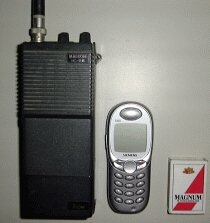Radiotelephone
Radiotelephone refers to a telecommunications device that allows two or more parties to conduct audio conversations over a distance using radio waves rather than through a wired connection. The technology behind radiotelephones has played a crucial role in the development of modern communication systems, enabling voice communication in areas where traditional telephone lines are impractical or unavailable.
History[edit | edit source]
The concept of the radiotelephone dates back to the early 20th century, with significant advancements during both World Wars. The initial development focused on military applications, providing a means for ships at sea and mobile ground units to communicate with each other and with command centers. The technology evolved from bulky, vehicle-mounted units to more portable designs.
How Radiotelephones Work[edit | edit source]
Radiotelephones operate by converting the user's voice into an electrical signal, which is then modulated onto a radio frequency (RF) carrier wave. This modulated signal is transmitted through the air by an antenna to a receiving station, where it is demodulated back into an audible electrical signal and then converted back into sound. The process relies on a combination of radio and telephone technologies, hence the name radiotelephone.
Types of Radiotelephones[edit | edit source]
There are several types of radiotelephones, including:
- Marine VHF radio: Used for communication between ships and with shore stations, operating in the very high frequency (VHF) range.
- Aircraft radio: Enables communication between aircraft and control towers or between aircraft in flight.
- Mobile radio: Used in vehicles or as handheld devices for various purposes, including emergency services and commercial operations.
- Satellite phone: A type of radiotelephone that communicates directly with orbiting satellites, allowing for global coverage.
Applications[edit | edit source]
Radiotelephones have a wide range of applications, from commercial and personal use to critical emergency services. They are essential in areas where traditional communication infrastructure is lacking or has been destroyed, such as in remote locations, on the high seas, and in disaster zones. Radiotelephones are also vital for safety in aviation and maritime operations, providing a reliable means of distress signaling and routine communication.
Regulation and Licensing[edit | edit source]
The use of radiotelephones is regulated by national and international bodies to prevent interference between different users and to ensure the efficient use of the radio spectrum. In many countries, operators of certain types of radiotelephones must hold a valid license, which typically requires passing a technical knowledge examination. The International Telecommunication Union (ITU) coordinates the allocation of radio frequencies internationally to minimize cross-border interference.
Challenges and Limitations[edit | edit source]
While radiotelephones have significantly improved communication capabilities in many scenarios, they are not without their challenges. These include limitations in range and bandwidth, susceptibility to interference, and the need for regulatory compliance. Additionally, the advent of cellular networks and satellite communications has provided alternatives to radiotelephone technology, though radiotelephones remain indispensable in specific applications.
Future of Radiotelephones[edit | edit source]
The future of radiotelephones lies in the continued integration with digital technologies, improving quality, increasing bandwidth, and enhancing security features. Despite the proliferation of advanced communication technologies, the basic principle of radiotelephone communication—direct, wireless voice communication—ensures its ongoing relevance in various fields.
This communication related article is a stub. You can help WikiMD by expanding it.
Search WikiMD
Ad.Tired of being Overweight? Try W8MD's physician weight loss program.
Semaglutide (Ozempic / Wegovy and Tirzepatide (Mounjaro / Zepbound) available.
Advertise on WikiMD
|
WikiMD's Wellness Encyclopedia |
| Let Food Be Thy Medicine Medicine Thy Food - Hippocrates |
Translate this page: - East Asian
中文,
日本,
한국어,
South Asian
हिन्दी,
தமிழ்,
తెలుగు,
Urdu,
ಕನ್ನಡ,
Southeast Asian
Indonesian,
Vietnamese,
Thai,
မြန်မာဘာသာ,
বাংলা
European
español,
Deutsch,
français,
Greek,
português do Brasil,
polski,
română,
русский,
Nederlands,
norsk,
svenska,
suomi,
Italian
Middle Eastern & African
عربى,
Turkish,
Persian,
Hebrew,
Afrikaans,
isiZulu,
Kiswahili,
Other
Bulgarian,
Hungarian,
Czech,
Swedish,
മലയാളം,
मराठी,
ਪੰਜਾਬੀ,
ગુજરાતી,
Portuguese,
Ukrainian
Medical Disclaimer: WikiMD is not a substitute for professional medical advice. The information on WikiMD is provided as an information resource only, may be incorrect, outdated or misleading, and is not to be used or relied on for any diagnostic or treatment purposes. Please consult your health care provider before making any healthcare decisions or for guidance about a specific medical condition. WikiMD expressly disclaims responsibility, and shall have no liability, for any damages, loss, injury, or liability whatsoever suffered as a result of your reliance on the information contained in this site. By visiting this site you agree to the foregoing terms and conditions, which may from time to time be changed or supplemented by WikiMD. If you do not agree to the foregoing terms and conditions, you should not enter or use this site. See full disclaimer.
Credits:Most images are courtesy of Wikimedia commons, and templates, categories Wikipedia, licensed under CC BY SA or similar.
Contributors: Prab R. Tumpati, MD

